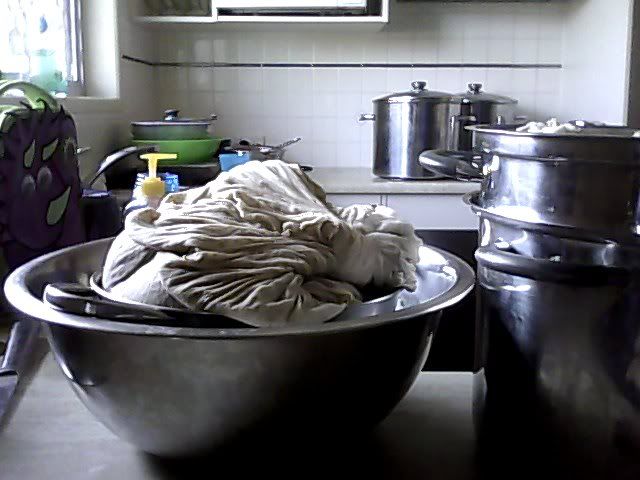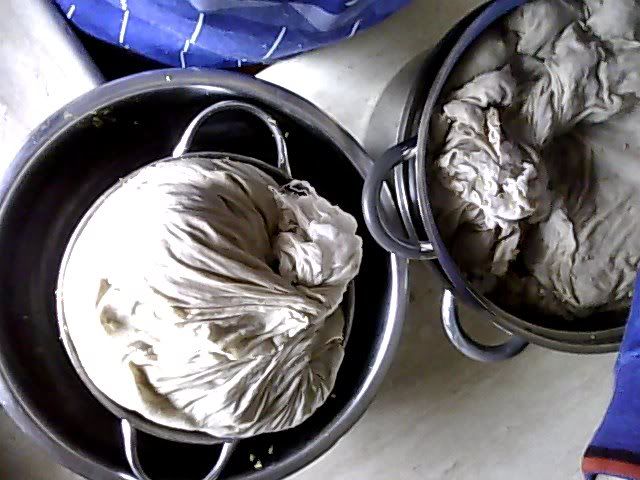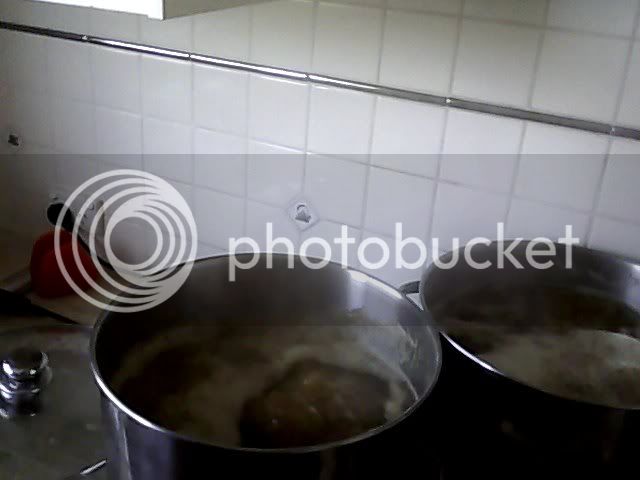As an addendum to Nick's method, and I willingly accede to his greater knowledge and experience, I thought I'd share a couple of shots of today's brew day and my altered stovetop method.
Why?
I do full sized (up to 30L) batches comfortably on the stove. Nick's method started me on doing AG BIAB-esque brewing, and I've altered it to do larger batches. This is handy when I know my house ale inside-out, and I just want to knock up some beer.
Advantages:
You can sparge (some say this is a disadvantage, but I like the increased efficiency).
Extra headspace (no boilovers)
Full sized batch
Good stepping stone if you don't want to pay for an urn, a bigger pot or Mongolian Burner.
Good if your space to brew is limited to your kitchen
Disadvantages:
Takes a little longer than the "true" BIAB method using an urn.
You can sparge (see above)
Requires a 2nd 19L big w pot (mine cost $12 on special)
What you need over and above Nick's method:
2nd big w pot
2 colanders and 2 receptacles for the sparged sugaz
What I do (differently to the Nick_JD method - I'm not going to outline the steps that are the same - I'm hoping that this is obvious):
Get my recipe into brewmate - I use the regular AG method (as I sparge), not the BIAB method setting.
Both pots are on the stove to get to strike temp (sorry for no pic, didn't think to do this until after), I'm doing single infusion, no mashout or anything else (though it is possible, given the extra headspace).
Material goes in (ignore later pic - I didn't put my piece in a gentle cycle, it got frayed and let out some grain - nothing a sieve doesn't fix).
Grain goes in, give it a good stir, put the lids on and insulate with doonas.
When mash is up, pick up each bag and put it into the designated colander sitting inside the receptacle so designated (piccy below):
(I took this after the sparge, but you get the idea).
Boil the kettle (or borrow another and run them concurrently to save time). Mine boils to 85 degrees, which according to brew mate is about perfect.
19L pots should be on the stove, working themselves up to boil temp.
Run the kettle over the bag of grain. Give the bag a bit of a squeeze. Return the sugaz back to the original pot. Repeat until you've sparged as much as brewmate says you should (in my case 17L all up, which means 8.5L per colander - this is the bit that increases the time. Having said that, it also increases the beer considerably, relative to 9L method)
Leave grain-bags in colander, as you will get a little leftover dregs to return during the boil:
By the time you have finished sparging, the boiling should be occurring:
(to all the experts, yes I will scrape that break off, but pictures first).
The rest is the same, boil for the required time, add the required hops (though split them into two and share the hop-love between the pots), whirflow, whirlpool, etc.
I do chill (in the sink, stir water around outside of pot, when it gets to about 40 degrees (I guess this), chuck in an ice brick or two into the water (not the wort) to bring it down to 20 degrees). Those that don't will find this method quicker than I do.
I hope this is of benefit to someone. It certainly makes great beer, though it does take longer than the other methods. It's the trade-off for cheapness. It'll probably add another 1/2 hour or so to the brew day, over an urn-based BIAB (the "true" BIAB if it's advocates are to be believed).
More importantly, it shows that any idiot (I'm their king) can apply a little ingenuity to a method, as befits their equipment and circumstances.
Cheers all,
Goomba







